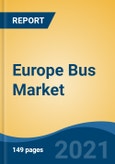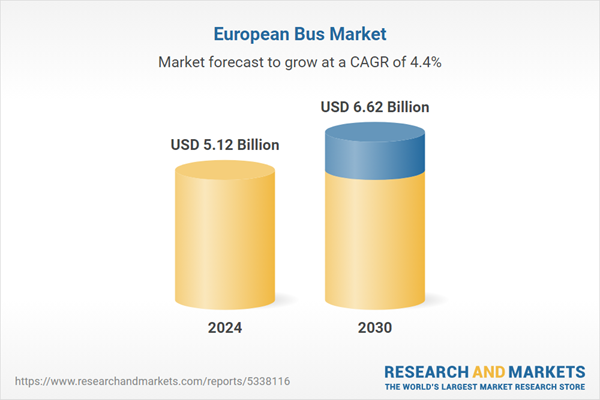Free Webex Call
The Europe Bus Market was valued at USD 5.12 Billion in 2024, and is expected to reach USD 6.62 Billion by 2030, rising at a CAGR of 4.40%. The market is experiencing steady growth driven by rising demand for eco-friendly urban transportation, government initiatives to modernize public transit systems, and the growing trend of shared mobility. Municipal authorities across Europe are prioritizing policies that address traffic congestion and emissions, resulting in increased investments in fuel-efficient and zero-emission buses. Fleet renewal programs, supported by incentives, are contributing to faster vehicle replacement cycles. Moreover, advancements in telematics, onboard safety systems, and passenger comfort features are enhancing operational efficiency and attracting ridership. Speak directly to the analyst to clarify any post sales queries you may have.
10% Free customizationThis report comes with 10% free customization, enabling you to add data that meets your specific business needs.
Ongoing digitalization trends - such as contactless ticketing and route optimization - are streamlining transit operations and improving commuter experience. Bus manufacturers are focusing on interior design improvements, noise insulation, and ergonomic upgrades to appeal to urban commuters. Modular vehicle designs that allow easy upgrades and reduce maintenance costs are gaining popularity. Collaborative initiatives between automotive firms, transit operators, and tech companies are accelerating the development of intelligent mobility solutions, particularly those powered by artificial intelligence and real-time analytics.
Market Drivers
Urbanization and Population Growth
As urban populations rise and cities expand, the demand for efficient and accessible public transport intensifies. Buses play a vital role in easing congestion and supporting growing commuter needs. With city limits extending into suburbs, transit authorities are developing integrated networks that include both long-distance and feeder routes. Investments in high-capacity buses and smarter routing systems are increasing to accommodate the expanding urban footprint.To support this growth, cities are implementing integrated ticketing systems that simplify transfers and improve affordability. Dedicated bus lanes are being deployed to reduce travel times and ensure reliable service. Commuters benefit from real-time tracking apps, which enhance route visibility and adaptability. Strategic urban planning is increasingly incorporating bus transit as a core component of sustainable mobility infrastructure.
Key Market Challenges
High Initial Investment
Modernizing bus fleets, particularly with electric or hydrogen-powered vehicles, involves substantial upfront expenditure. These advanced buses are significantly more expensive than their diesel counterparts, placing a financial strain on both public agencies and private fleet operators. Battery technology costs, the need for charging or refueling infrastructure, and limited financing options present additional hurdles.Even when subsidies are available, long payback periods delay procurement decisions. Financiers are often hesitant to support high-cost vehicle purchases, and uncertainties around residual value limit resale potential. Warranty coverage, especially for batteries, is often insufficient, increasing long-term risk. Smaller operators face challenges due to underdeveloped financing models, and project timelines are frequently delayed due to budget constraints.
Key Market Trends
Electrification of Bus Fleets
The shift toward electric buses is gaining momentum across Europe, driven by strict emissions regulations and sustainability goals. In 2023, battery-electric buses accounted for 36% of new city bus registrations in the EU, surpassing diesel for the first time. Cities like Berlin and Paris have set ambitious goals to fully electrify their fleets by 2030. Improved battery range, faster charging capabilities, and dedicated infrastructure investments are fueling this transition.Bus manufacturers are responding with innovative offerings - such as Solaris’s Urbino 12 electric, which delivers up to 600 km per charge. National and local governments are offering incentives and funding programs that not only subsidize bus purchases but also support the development of supporting infrastructure. Integration of renewable energy into charging networks further enhances the environmental impact. Awareness campaigns are increasing public acceptance, and falling costs are improving the long-term economics of electric bus adoption for fleet operators.
Key Market Players
- Toyota Motor Corporation
- Mercedes (Daimler AG)
- Isuzu Motors Ltd.
- Mitsubishi Fuso Truck and Bus Corporation
- Zhengzhou Yutong Bus Co. Ltd.
- Ashok Leyland Ltd.
- Tata Motors Ltd.
- Xiamen King Long United Automotive Industry Co. Ltd.
- AB Volvo
- MAN Truck & Bus
Report Scope:
In this report, the Europe Bus Market has been segmented into the following categories, in addition to the industry trends which have also been detailed below:Europe Bus Market, By Application:
- Transit Buses
- Motor Coaches
- School Buses
- Others
Europe Bus Market, By Fuel Type:
- Diesel
- Petrol
- CNG
- Electric
Europe Bus Market, By Seating Capacity:
- Up to 30 seats
- 31-50 seats
- More than 50 seats
Europe Bus Market, By Length:
- Up to 8 m
- 8 m to 10 m
- 10 m - 12 m
- Above 12 m
Europe Bus Market, By Country:
- France
- United Kingdom
- Italy
- Germany
- Spain
- Belgium
- Switzerland
- Netherlands
Competitive Landscape
Company Profiles: Detailed analysis of the major companies present in the Europe Bus Market.Available Customizations:
With the given market data, the publisher offers customizations according to the company’s specific needs. The following customization options are available for the report.Company Information
- Detailed analysis and profiling of additional market players (up to five).
This product will be delivered within 1-3 business days.
Table of Contents
1. Introduction
2. Research Methodology
3. Executive Summary
4. Europe Bus Market Outlook
5. France Bus Market Outlook
6. United Kingdom Bus Market Outlook
7. Italy Bus Market Outlook
8. Germany Bus Market Outlook
9. Spain Bus Market Outlook
10. Belgium Bus Market Outlook
11. Switzerland Bus Market Outlook
12. Netherlands Bus Market Outlook
13. Market Dynamics
16. Competitive Landscape
Companies Mentioned
- Toyota Motor Corporation
- Mercedes (Daimler AG)
- Isuzu Motors Ltd.
- Mitsubishi Fuso Truck and Bus Corporation
- Zhengzhou Yutong Bus Co. Ltd.
- Ashok Leyland Ltd.
- Tata Motors Ltd.
- Xiamen King Long United Automotive Industry Co. Ltd.
- AB Volvo
- MAN Truck & Bus
Table Information
| Report Attribute | Details |
|---|---|
| No. of Pages | 123 |
| Published | July 2025 |
| Forecast Period | 2024 - 2030 |
| Estimated Market Value ( USD | $ 5.12 Billion |
| Forecasted Market Value ( USD | $ 6.62 Billion |
| Compound Annual Growth Rate | 4.4% |
| Regions Covered | Europe |
| No. of Companies Mentioned | 10 |









